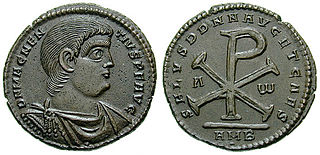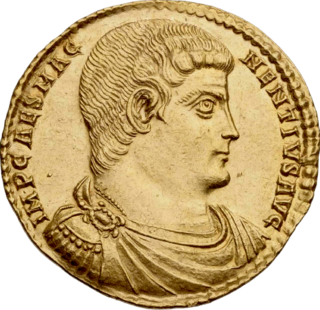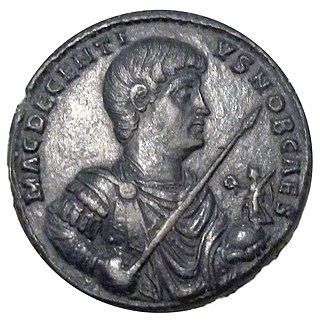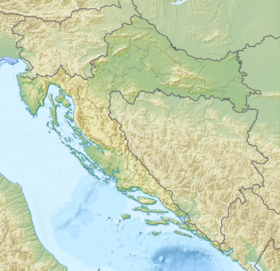
Constantius II was Roman emperor from 337 to 361. His reign saw constant warfare on the borders against the Sasanian Empire and Germanic peoples, while internally the Roman Empire went through repeated civil wars, court intrigues, and usurpations. His religious policies inflamed domestic conflicts that would continue after his death.

Flavius Julius Constans, also called Constans I, was Roman emperor from 337 to 350. He held the imperial rank of caesar from 333, and was the youngest son of Constantine the Great.

Constantine II was Roman emperor from 337 to 340. Son of Constantine the Great and co-emperor alongside his brothers, his attempt to exert his perceived rights of primogeniture led to his death in a failed invasion of Italy in 340.

The Tetrarchy was the system instituted by Roman emperor Diocletian in 293 AD to govern the ancient Roman Empire by dividing it between two emperors, the augusti, and their junior colleagues and designated successors, the caesares.
The 350s decade ran from January 1, 350, to December 31, 359.

Year 351 (CCCLI) was a common year starting on Tuesday of the Julian calendar. At the time, it was known as the Year of the Consulship of Magnentius and Gaiso. The denomination 351 for this year has been used since the early medieval period, when the Anno Domini calendar era became the prevalent method in Europe for naming years.

Year 350 (CCCL) was a common year starting on Monday of the Julian calendar. At the time, it was known as the Year of the Consulship of Sergius and Nigrinianus. The denomination 350 for this year has been used since the early medieval period, when the Anno Domini calendar era became the prevalent method in Europe for naming years.

Magnus Magnentius was a Roman general and usurper against Constantius II. Of Germanic descent, Magnentius served with distinction in Gaul under the emperor Constans. On 18 January 350 Magnentius was acclaimed Augustus. Quickly killing the unpopular Constans, Magnentius gained control over most of the Western Empire. The Eastern emperor Constantius II, the brother of Constans, refused to acknowledge Magnentius' legitimacy and led a successful campaign against Magnentius. Ultimately, Magnentius' forces were scattered after the Battle of Mons Seleucus, and he committed suicide on 10 August 353.

Flavius Claudius Constantius Gallus (326–354) was a statesman and ruler in the eastern provinces of the Roman Empire from 351 to 354, as Caesar under emperor Constantius II, his cousin. A grandson of emperor Constantius Chlorus and empress Flavia Maximiana Theodora, and a son of Julius Constantius and Galla, he belonged to the Constantinian dynasty. Born during the reign of his uncle Constantine the Great, he was among the few male members of the imperial family to survive the purge that followed Constantine's death. Under Constantius II, Gallus served as deputy emperor, based in Antioch and married to Constantius' sister Constantina. He dealt with a Jewish revolt in the years 351-352. Gallus ultimately fell out of favor with Constantius and was executed, being replaced as Caesar by his younger half-brother Julian.

Vetranio was briefly Western Roman emperor in 350, allying with the Eastern emperor Constantius II in his war against Magnentius.

The Battle of Mons Seleucus was fought in 353 between the armies of the Roman emperor Constantius II and the usurper Magnentius. Constantius' forces were victorious. Support for Magnentius had been eroding since his defeat at the Battle of Mursa Major two years prior; after Mons Seleucus his cause collapsed and he killed himself.

Magnus Decentius was caesar of the Western Roman Empire from 350 to 353, under his brother Magnentius.

Marcellinus was a Roman Empire officer under Roman Emperor Constans and usurper Magnentius.

The Roman civil war of 350–353 AD was a war fought between the Roman emperor Constantius II and the usurper Magnentius.

Byzantine Empire under the Constantinian and Valentinianic dynasties was the earliest period of the Byzantine history that saw a shift in government from Rome in the West to Constantinople in the East within the Roman Empire under emperor Constantine the Great and his successors. Constantinople, formally named Nova Roma, was founded in the city of Byzantium, which is the origin of the historiographical name for the Eastern Empire, which self-identified simply as the "Roman Empire".
Vulcacius Rufinus was a Roman politician, related to the Constantinian dynasty.
Aurelius Celsinus was a politician of the Roman Empire.
Flavius Romulus was a Roman politician, appointed to the high position of consul in 343. The historian Benet Salway tentatively identified him with Romulus, the senior army officer who fought and died for the usurper Magnentius at the Battle of Mursa in 351.
The Perso-Roman wars of 337–361 were a series of military conflicts fought between the Roman Empire and the Sasanian Empire between 337 and 361. They were a result of long-standing competition between the rival powers over influence in the border kingdoms of Armenia and Iberia, as well as the desire of Shapur II, after his Arab campaign, to revoke the unfavorable terms of the Treaty of Nisibis, which had concluded the previous war between the empires. Though the Romans under Constantius II were defeated in several sanguinary encounters, Shapur was unable to secure a decisive victory.











